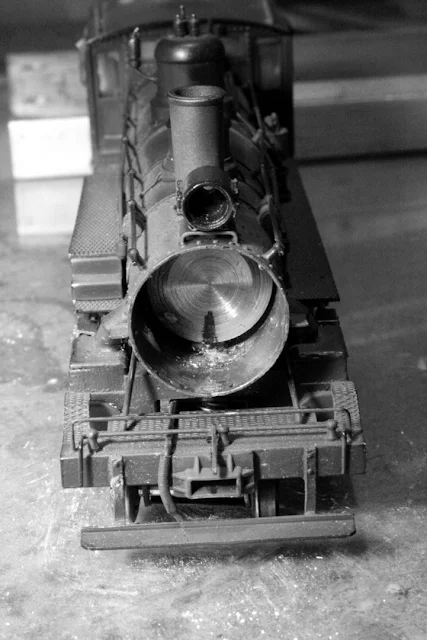 |
| A custom weight helps tailor this model to its intended purpose |
With the weight finalized in the Gem Models 4-6-0 the locomotive pulled a train of 17.75oz with "rare" slipping. Additional weight was loaded progressively onto the 1oz test car until the slipping increased to substantially more spinning than forward motion. The maximum weight with any forward motion was 23oz therefore I rated the engine
 |
| Each disk is about 0.35oz or 0.7oz in the cab |
tonnage as 17,75oz on a 2% grade.
Up to this point, I had used the test car (with Intermountain Models plastic trucks) with a range of weights that could be combined to any multiple of 1/4oz. It was time to take the investigation to the next level.
I still have an old copy of HO Primer by Linn Wescott. This was the go-to hand book for HO modelers in the '60s and '70.
I briefly review the chapter on rolling stock and found that the recommendation was 1/2oz for every inch of car plus 1 extra ounce. A 40' boxcar in HO is 5.5" long over the end sills. According to HO Primer and the NMRA such a car should weigh 3oz with one additional ounce overall for a total of 4oz.
 |
| The weighted test car was 18oz with no slipping @ 2% |
Of course in those days Truck technology wasn't quite what it is today. On the other hand, mass produced model locomotives shells were all metal and rather more heavy. They could pull more.
I collected together a train's worth of Moore & Moore Lines freight cars - in this case 5 Central Valley Old Timers. I checked and marked the weight of each cars in order to tally the total train "tonnage". The M&ML cars are 36 footers or just under 5" long. They should weigh 3.5oz. according to the given sources but they are all between 2.2oz and 2.95 oz - a little light. The
total weight of the 5 cars is 13.25oz. The flat car with an incomplete caboose on top weighs 3oz. The total train weight is 16.25oz.
 |
| The Gem Models Ten Wheeler marched up 2% with 20 1/4oz not counting the 3.25oz tender |
Initially, the locomotive did well since the train weight was well below the engine's proven capability. Then I did something radical; or so it might seem these days (we being conditioned to high quality plastic trucks that will take off if you just look down hill). I oiled all of the axles including those of the tender. The cars I used for testing are true Central Valley kits that came with their wonderful metal trucks.They have been upgrade, however, with NWSL fine scale (Code 88) axle sets. The results were quite interesting.
Again, weight was progressively added to the flat until at 22oz the wheel slip was notable (meaning; the drivers clearly slip with every revolution). I backed the weight off and redefined the engine's tonnage as 20oz at 2%. This was an increase of more than 2oz and that can make it possible to add 1 more car to the train.
The average Central Valley house car on the M&ML weights 2.65oz. This locomotive can handle a 6 car train plus caboose over the steepest hill on the line. Of course, that is longer than the line's only passing track.
 |
| Worn 40lb rail from Schwanders CO - C&Sng |
Slipping wheels are not a to be tolerated. Slipping wheels can mean tread wear or in the case of stainless steel tires, rail wear. (Both are prototypical by the way; but nobody really wants to model that!) .
To summarize, handling locomotive weight intelligently can increase your enjoyment of the hobby. The encumbrances are that there are many variables, yet seemingly, there is very little discussion about the topic. Of course diesel (pronounced "disease-zel") modelers need not be as attentive because weight is pretty linear in their world. Intelligently balanced, a model steam engine may well out-pull a like model mindlessly crammed full of lead - even if the latter weighs more. Adding too much weight can also mean a shortened life of the power train.
Below are the stats on this model and a brief of the steps taken to arrive at the best pulling capability.
Tests model; Gem Models 4-6-0. Built by Olympic Models (Tokyo) 12-6-'62.
Modernized Power Train; Sept '18 with NWSL 1630D-9 motor (0.75oz) with flywheel (0.25oz). Balance w/o boiler weight = +1.0oz to front.Procedures: (Note all train weight total values exclude weight of tender.)
1) (No boiler weight) Added 1/2oz to cab; @ 2% locomotive pulled 9oz plus 1oz car = 10oz Occasional slipping.
2) Added original boiler weight (1.7oz) plus 1.75oz to cab; Train weight of ~20oz @ 2%. Stalled (full wheel slip).
3) Added
5/8"o.d. x 1.1" tube w/ buckshot for total 1.25oz to boiler. Pulled
13oz without weight to cab. Added 0.75oz to cab. Pulled 17.75oz total @ 2%. Engine weight = 8.25oz, tender = 3.25oz, total locomotive 11.5oz
Then:
@2%, 5 cars plus caboose on flat = 16.25oz.total. Occasional slipping. Checked and lubricated all car and tender axles. Progressively added 5oz for 21.25oz total (until common slipping). Reduced train weight by 0.75oz to 20.5oz for rare slipping - Total train weight 20.5oz. The Moore & Moore Lines has officially rated this locomotives tonnage @ 20oz on a 2% grade.
 |
| Central Valley cars of the Moore & Moore Lines weighed and marked for tonnage purposes |










